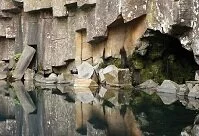Weather

Jeju Island
Summers in South Korea consist of the time between about June to about September, but this time is also the monsoon or rainy season. Temperatures in Seoul average about 75°F (25°C) during this time, while the mountains are cooler, but all of the country, particularly in the south and west, receives a fair amount of humidity and rain. Winters hover right around the freezing point with the mountains remaining below that point for much of winter and the coasts typically getting above during days so snow doesn't tend to remain on the ground long. The fall (autumn) tends to be fairly warm and sunny as the changing leave colors attract a fair amount of tourists. Likewise, the spring draws a lot of tourists, including many locals as the Cherry Blossoms are in full color in March-May.
Wildlife
There are a fair number of animals in South Korea, both large and small. Among the larger mammals are leopards, panthers, deer, and wolves. There are also smaller mammals such as the boar, squirrels, mice, and bats. There are also a number of species in the waters surround the country, including the mammalian whales and dolphins. There are also sharks, tuna, eels, shellfish, and more.
The bird life in South Korea is substantial as many species migrate to and from the country. Among the most commonly seen birds are teals, swans, flycatchers, ibis, and buzzards. Among the reptiles and amphibians are turtles, snakes, lizards, salamanders, frogs, and toads.